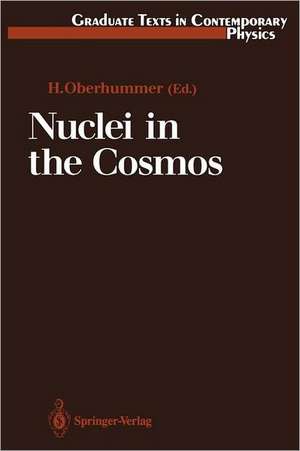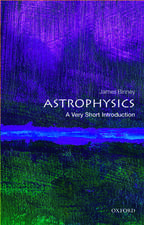Nuclei in the Cosmos: Graduate Texts in Contemporary Physics
Editat de Heinz Oberhummer Contribuţii de J.H. Applegate, J.J. Cowan, F. Käppeler, H. V. Klapdor-Kleingrothaus, K. Langanke, R.A. Malaney, H. Oberhummer, B.E.J. Pagel, C. Rolfs, G. Schatz, G. Staudt, F.-K. Thielemann, J. Vervier, M. Wiescheren Limba Engleză Paperback – 27 iun 2012
Din seria Graduate Texts in Contemporary Physics
- 17%
 Preț: 395.10 lei
Preț: 395.10 lei - 18%
 Preț: 1028.15 lei
Preț: 1028.15 lei - 18%
 Preț: 744.22 lei
Preț: 744.22 lei - 15%
 Preț: 588.04 lei
Preț: 588.04 lei -
 Preț: 393.52 lei
Preț: 393.52 lei - 18%
 Preț: 805.29 lei
Preț: 805.29 lei - 15%
 Preț: 593.91 lei
Preț: 593.91 lei -
 Preț: 397.01 lei
Preț: 397.01 lei - 18%
 Preț: 809.07 lei
Preț: 809.07 lei -
 Preț: 394.71 lei
Preț: 394.71 lei -
 Preț: 399.88 lei
Preț: 399.88 lei - 15%
 Preț: 651.67 lei
Preț: 651.67 lei - 15%
 Preț: 609.14 lei
Preț: 609.14 lei - 15%
 Preț: 599.14 lei
Preț: 599.14 lei - 15%
 Preț: 596.36 lei
Preț: 596.36 lei -
 Preț: 388.90 lei
Preț: 388.90 lei - 15%
 Preț: 538.61 lei
Preț: 538.61 lei -
 Preț: 402.56 lei
Preț: 402.56 lei - 15%
 Preț: 542.04 lei
Preț: 542.04 lei - 15%
 Preț: 591.14 lei
Preț: 591.14 lei -
 Preț: 395.47 lei
Preț: 395.47 lei -
 Preț: 383.33 lei
Preț: 383.33 lei -
 Preț: 394.29 lei
Preț: 394.29 lei -
 Preț: 382.36 lei
Preț: 382.36 lei -
 Preț: 400.47 lei
Preț: 400.47 lei -
 Preț: 385.47 lei
Preț: 385.47 lei
Preț: 385.62 lei
Nou
Puncte Express: 578
Preț estimativ în valută:
73.79€ • 77.25$ • 61.05£
73.79€ • 77.25$ • 61.05£
Carte tipărită la comandă
Livrare economică 07-21 aprilie
Preluare comenzi: 021 569.72.76
Specificații
ISBN-13: 9783642488429
ISBN-10: 3642488420
Pagini: 252
Ilustrații: XII, 236 p.
Dimensiuni: 155 x 235 x 13 mm
Greutate: 0.36 kg
Ediția:Softcover reprint of the original 1st ed. 1991
Editura: Springer Berlin, Heidelberg
Colecția Springer
Seria Graduate Texts in Contemporary Physics
Locul publicării:Berlin, Heidelberg, Germany
ISBN-10: 3642488420
Pagini: 252
Ilustrații: XII, 236 p.
Dimensiuni: 155 x 235 x 13 mm
Greutate: 0.36 kg
Ediția:Softcover reprint of the original 1st ed. 1991
Editura: Springer Berlin, Heidelberg
Colecția Springer
Seria Graduate Texts in Contemporary Physics
Locul publicării:Berlin, Heidelberg, Germany
Public țintă
ResearchCuprins
Experimental Determination of Stellar Reaction Rates.- 1. Introduction.- 2. Direct Measurements.- 3. Indirect Approaches.- 4. Reactions Involving Radioactive Nuclides.- References.- Radioactive Ion Beams in Nuclear Astrophysics.- 1. Introduction.- 2. Interest of Radioactive Ion Beams in Nuclear Astrophysics.- 3. Production of Radioactive Ion Beams.- 4. Special Experimental Techniques in Nuclear Astrophysics Using Radioactive Ion Beams.- 5. Conclusions.- References.- Direct Reaction Mechanism in Astrophysically Relevant Processes.- 1. Introduction.- 2. Qualitative Features of Nuclear Reaction Mechanisms.- 3. Nuclear Reactions in Astrophysical Scenarios.- 4. Optical Potentials.- 5. Theoretical Descriptions of Direct Reactions.- 6. Examples.- 7. Summary.- Acknowledgements.- References.- Nuclear Reaction Rates — from Laboratory Experiments and in the Stellar Plasma.- 1. Introduction.- 2. Theoretical Models for Extrapolating Measured Data.- 3. Electron Screening in Laboratory Experiments.- 4. Screening Effects in the Plasma.- References.- Abundances in Galaxies.- 1. Introduction.- 2. Big Bang Nucleosynthesis and Light Element Abundances.- 3. Abundance Trends Between and Across Galaxies.- 4. Stellar Populations in Our Galaxy.- 5. Differential Abundance Variations Among Elements.- References.- Nuclei in Cosmic Rays.- 1. Introduction.- 2. Techniques for Measuring Composition from Satellites and Balloons.- 3. Results of Satellite and Balloon Experiments.- 4. How to Measure Cosmic Ray Composition above 1015 eV.- 5. Summary.- References.- Primordial Nucleosynthesis: Beyond the Standard Model.- 1. Introduction.- 2. Standard Primordial Nucleosynthesis.- 3. Observational Tests of the Standard Model.- 4. The QCD Phase Transition.- 5. Neutrinos in the Early Universe.- 6. CosmicStrings.- 7. Conclusions.- References.- Production of Heavy Elements in Inhomogeneous Cosmologies.- 1. Introduction.- 2. The QCD Transition in the Early Universe.- 3. The Standard Big Bang.- 4. Inhomogeneous Big Bang Scenarios.- 5. Computational Method.- 6. Results.- Acknowledgements.- References.- The s-Process: Branchings and Chronometers.- 1. Introduction.- 2. Chronometers — Models and Reality.- 3. s-Process Concepts.- 4. s-Process Time Scales.- 5. Selected Examples.- 6. Conclusions.- References.- Beta Decay Far from Stability and Double Beta Decay, and Consequences for Astrophysics.- 1. Introduction.- 2. Calculations of Beta Decay Properties of Nuclei Far from Stability.- 3. Beta Decay Far from Stability and the Astrophysical r-Process.- 4. The r-Process and the Age of the Universe.- 5. Age of the Universe, Cosmology and Neutrino Mass.- 6. Double Beta Decay and Neutrino Mass.- 7. Conclusion.- References.













